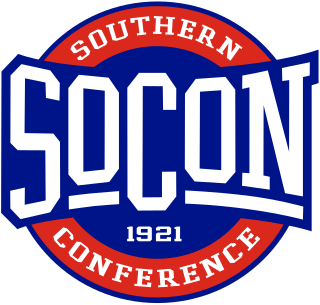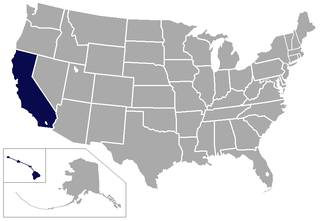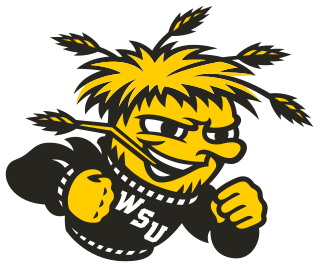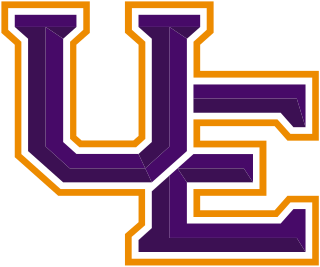Related Research Articles

The Big Sky Conference is a collegiate athletic conference affiliated with the NCAA's Division I with football competing in the Football Championship Subdivision. As of 2023, full member institutions are located in the states of Arizona, California, Colorado, Idaho, Montana, Oregon, Utah, and Washington. Two affiliate members from California are football–only participants.

The Southern Conference (SoCon) is a collegiate athletic conference affiliated with the National Collegiate Athletic Association (NCAA) Division I. Southern Conference football teams compete in the Football Championship Subdivision. Member institutions are located in the states of Alabama, Georgia, North Carolina, South Carolina, Tennessee, and Virginia.

The Big West Conference (BWC) is an American collegiate athletic conference whose member institutions participate in the National Collegiate Athletic Association's Division I. The conference was originally formed on July 1, 1969, as the Pacific Coast Athletic Association (PCAA), and in 1988 was renamed the Big West Conference. The conference stopped sponsoring college football after the 2000 season.

The Pittsburgh Panthers, commonly also referred to as the Pitt Panthers, are the athletic teams representing the University of Pittsburgh, although the term is colloquially used to refer to other aspects of the university such as alumni, faculty, and students. Pitt fields 19 university-sponsored varsity teams at the highest level of competitive collegiate athletics in the United States: the NCAA Division I Football Bowl Subdivision (FBS) for American football.

The Pacific Coast Conference (PCC) was a college athletic conference in the United States which existed from 1915 to 1959. Though the Pac-12 Conference claims the PCC's history as part of its own, with eight of the ten PCC members now in the Pac-12, the older league had a completely different charter and was disbanded in 1959 due to a major crisis and scandal.

Darrell E. Mudra Sr., nicknamed "Dr. Victory", was an American football coach. He served as the head football coach at Adams State College (1959–1962), North Dakota State University (1963–1965), the University of Arizona (1967–1968), Western Illinois University (1969–1973), Florida State University (1974–1975), Eastern Illinois University (1978–1982), and the University of Northern Iowa (1983–1987), compiling a career college football record of 200–81–4. Mudra was also the head coach of the Montreal Alouettes of the Canadian Football League (CFL) for one season in 1966. He was inducted into the College Football Hall of Fame as a coach in 2000.

The Louisiana Ragin' Cajuns are the athletic teams of the University of Louisiana at Lafayette. The college has been competing athletically since 1901. The Ragin' Cajuns compete in NCAA Division I, fielding 16 varsity teams.

The Western Michigan Broncos are a National Collegiate Athletic Association (NCAA) Division I program representing Western Michigan University (WMU) in college athletics. They compete in the Mid-American Conference in men's baseball, basketball, football, and tennis; and women's basketball, cross-country, golf, gymnastics, soccer, softball, track and field, and volleyball. The men's ice hockey team competes in the National Collegiate Hockey Conference and the men's soccer team competes in the Missouri Valley Conference. The Broncos also have a flight team, the SkyBroncos, who have won the National Intercollegiate Flying Association (NIFA) National Championship award five times.

The UC Santa Barbara Gauchos are the intercollegiate athletic teams who represent the University of California, Santa Barbara. Referred to in athletic competition as UC Santa Barbara or UCSB, the Gauchos participate in 19 NCAA Division I intercollegiate sports with the majority competing in the Big West Conference. UCSB currently fields varsity teams in 10 men's sports and 9 women's sports.

The Saint Louis Billikens are the collegiate athletic teams that represent Saint Louis University, located in St. Louis, Missouri. The Billikens compete in Division I of the National Collegiate Athletic Association (NCAA) as a member of the Atlantic 10 Conference. The school has nationally recognized soccer programs for men and women. The school has heavily invested in its on-campus athletic facilities since the 1990s with the creation of Hermann Stadium and Chaifetz Arena. Chris May is the current director of athletics of the St. Louis Billikens.

The Wichita State Shockers are the athletic teams that represent Wichita State University, located in Wichita, Kansas, in intercollegiate sports as a member of the NCAA Division I ranks, primarily competing in the American Athletic Conference since the 2017–18 academic year. The Shockers previously competed in the D-I Missouri Valley Conference (MVC) from 1945–46 to 2016–17; as an Independent from 1940–41 to 1944–45; in the Central Intercollegiate Athletic Conference (CIC) from 1923–24 to 1939–40; and in the Kansas Collegiate Athletic Conference (KIAC) of the National Association of Intercollegiate Athletics (NAIA) from 1902–03 to 1922–23. As of the 2023 conference realignment, it is one of two schools in The American to have never been a member of Conference USA, although it will become a single-sport member of that conference for bowling in 2024. They are also currently the only non-football-sponsoring institution that is a member of an FBS conference.

The Denver Pioneers are the sports teams of the University of Denver (DU). They play in the National Collegiate Athletic Association (NCAA) Division I, and have amassed 35 NCAA titles as of 2024, which is in the top 15 among all schools. Denver is a member of The Summit League for men's and women's basketball, swimming and diving, men's and women's soccer, tennis and golf for both men and women, plus women's volleyball. Other DU teams play in various conferences in the sports that are not sponsored by The Summit. The men's ice hockey team is a charter member of the National Collegiate Hockey Conference (NCHC), which formed in 2011 with play beginning in 2013. The lacrosse teams for men and women are members of the Big East Conference; the men began Big East play in the 2013–14 school year, while the women left the Mountain Pacific Sports Federation (MPSF) after the 2016 lacrosse season. Men's and women's skiing compete in the Rocky Mountain Intercollegiate Ski Association, while the women's gymnastics team became an affiliate of the Big 12 Conference starting with the 2015–16 season.
The NCAA College Division was a historic subdivision of the National Collegiate Athletic Association (NCAA) consisting of member schools competing at a lower level of college sports. The NCAA initially divided schools into a College Division and a University Division. The College Division was split into two smaller groups in 1973 with the creation of NCAA Division II, which allows its members to award limited athletic scholarships, and Division III, which prohibits athletic scholarships.

The Lamar Cardinals and Lady Cardinals refers to the college athletics teams of Lamar University, in Beaumont, Texas. The Cardinals and Lady Cardinals teams compete in seventeen NCAA Division I sports as a member of the Southland Conference. The Cardinals rejoined the Southland after spending the 2021–22 athletic year in the Western Athletic Conference (WAC).

The Evansville Purple Aces are the intercollegiate sports teams and players of the University of Evansville, located in Evansville, Indiana. The Aces athletic program is a member of the Missouri Valley Conference and competes at the NCAA's Division I level. Evansville's mascot is Ace Purple, and the school colors are purple, white and orange.

The Houston Christian Huskies, HCU or Huskies are the athletic teams that represent Houston Christian University, located in Houston, Texas, in intercollegiate sports as a member of the Division I level of the National Collegiate Athletic Association (NCAA), primarily competing in the Southland Conference for most of its sports since the 2013–14 academic year; as of the current 2023 NCAA soccer season, its men's soccer team competes in the Ohio Valley Conference (OVC). The Huskies previously competed the D-I Great West Conference from 2008–09 to 2012–13 after spending one season as an NCAA D-I Independent during the 2007–08 school year ; in the Red River Athletic Conference (RRAC) of the National Association of Intercollegiate Athletics (NAIA) from 1998–99 to 2006–07; and as an NAIA Independent from 1989–90 to 1997–98. Houston Christian's (HCU) official school colors are royal blue and orange.

The RIT Tigers are composed of 22 teams representing Rochester Institute of Technology in intercollegiate athletics, including men and women's basketball, crew, cross country, cheerleading, ice hockey, lacrosse, soccer, swimming & diving, tennis, and track and field. Men's sports include baseball and wrestling. Women's sports include softball, and volleyball. The Tigers compete in the NCAA Division III and are members of the Liberty League for all sports except ice hockey, which competes in NCAA Division I. The men's ice hockey team is a member of Atlantic Hockey, while the women's ice hockey team is a member of College Hockey America.
The Indiana Collegiate Conference (ICC) was a men's college athletic conference in the United States, in existence from 1950 to 1978. It consisted solely of schools in Indiana.

The St. Edward's Hilltoppers are the athletic teams that represent St. Edward's University, located in Austin, Texas, in NCAA Division II intercollegiate sporting competitions. The Hilltoppers compete as members of the Lone Star Conference for all 13 varsity sports. St. Edward's was a member of the Heartland Conference from 1999 to 2019.
The Hoosier College Conference (HCC) was a men's intercollegiate athletics conference founded in 1947 by eight members of the Indiana Intercollegiate Conference. After consisting solely of colleges in Indiana for 24 years, the conference changed its name in 1971 to the Hoosier-Buckeye Collegiate Conference (HBCC) to reflect the admission of schools in Ohio. It existed for another 15 years in its rebranded form.
References
- ↑ "NCAA Group Opens Talks On Money Aid To Players". Kingsport Times. August 20, 1956. p. 7 – via Newspapers.com.
- ↑ "Playoffs For National Title Shots Face Leading Cage Teams". The Corsicana Daily Sun. March 11, 1957. p. 8 – via Newspapers.com.
- ↑ "Coach Wilson Is Named To NCAA Rating Board". Owensboro Messenger and Inquirer. December 18, 1957. p. 8A – via Newspapers.com.
- ↑ "Bowl Survey May Lead To Tighter Code". The Miami News. December 12, 1962. p. 32 – via Newspapers.com.
- ↑ "NCAA Widens Its Program For Next Year". The Press Democrat. August 14, 1963. p. 23 – via Newspapers.com.
- ↑ "Academic Rule Okayed by Most NCAA Groups". Clarion-Ledger. February 20, 1966. p. 43.
- ↑ "Status Of Furman, Davidson Being Reviewed By NCAA". The Greenville News. August 6, 1965. p. 30.("Classifications are not made by conferences . . . and being in the Southern Conference does not automatically make a school be of major standing. Nor does one sport affect another.")
- ↑ "Big Sky to Stay In NCAA Division". The Billings Gazette. May 24, 1967. p. 14 – via Newspapers.com.
- ↑ "ASC To Compete In University Division". Irving Daily News. January 16, 1967. p. 8 – via Newspapers.com.
- 1 2 "Northern Football Program Granted University Status". Journal Gazette. July 1, 1969.
- ↑ Tommy Devine (December 12, 1962). "Bowl Survey May Lead To Tighter Code". The Miami News. p. 32 – via Newspapers.com.
- ↑ "NCAA Lists New Events". Tulare Advance-Register. August 15, 1963. p. 4 – via Newspapers.com.
- ↑ "Ostyn says Pacific cost major status". Spokesman-Review. (Spokane, Washington). Associated Press. August 9, 1967. p. 15.
- 1 2 "NCAA ups 4 colleges". Pittsburgh Post-Gazette. Associated Press. July 2, 1969. p. 22.
- ↑ "Ball State Sports Go Into a New Era . . . New Coaches and 'Faster Leagues'". Muncie Evening Press. September 10, 1968. p. C8 – via Newspapers.com.
- ↑ "65 Colleges Playing 11 Tilts in '70". Austin American-Statesman. September 15, 1970 – via Newspapers.com.
- ↑ "Two Elevated To University NCAA Status". Colorado Springs Gazette-Telegraph. June 16, 1971 – via Newspapers.com.
- ↑ "Colleges Open Schedule Soon". Dayton Daily News. September 3, 1972 – via Newspapers.com.
